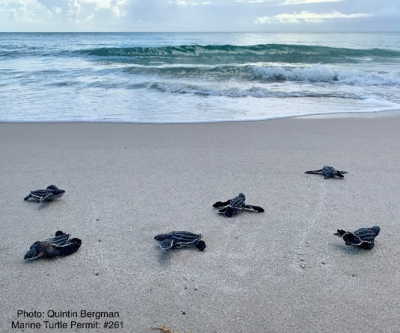Leatherback Sea Turtles Beat County Records
Indian River County's Coastal Division reports that the 2022 sea turtle nesting season so far has been particularly eggs-cellent for leatherback sea turtles. Since 2005, the County’s Sea Turtle Conservation Program has recorded an average of 50 leatherback nests per season. So far this season, the leatherbacks have laid 96 nests already, thereby breaking the record-high of 87 nests achieved during the entire 2010 season!
The leatherback sea turtle is one of the most impressive reptiles in the world. During the summer, they leave the artic waters near Nova Scotia to migrate 3,000 miles to Florida and other tropical beaches to nest. They are Florida’s largest sea turtle averaging 6 feet in length and weighing 500-1,500 pounds. Named for their rubbery shell, leatherbacks are covered with a firm, leathery skin and have seven ridges running lengthwise down their backs. They are usually black with white, pink and blue splotches.
Each of these nests in Indian River County likely contains a clutch of approximately 75 eggs. Sadly, on average, only one out of 1,000 hatchling will survive to adulthood. Leatherback populations are listed as “endangered” at the State and Federal levels.
The Sea Turtle Conservation Program monitors sea turtle nesting activity along sandy beaches in the County, including in Orchid. The sea turtle nesting season is from March 1 to October 31. During the nesting season, the County’s Program coordinates an effort to record every crawl from the previous night. It’s important to note that nests aren’t always physically marked, but may only be geotagged. In Orchid several nests have been visibly cordoned off, but more may only have been digitally tagged. Digging on the beach is strongly discouraged during the nesting season. Holes should be covered back over to allow arriving sea turtles to more easily navigate a smooth beach.
In addition to leatherback sea turtle nests, 5,838 loggerhead sea turtle nests and 741 green sea turtle nests have also been counted so far in 2022. Green sea turtles are also considered endangered, while loggerhead turtles are identified as threatened.
During sea turtle nesting season, it’s important that lights illuminating dune crosswalks be covered, especially now that nests have begun hatching. Hatchlings can become disoriented by artificial light. If you are lucky and encounter the magical sight of these baby turtles making their journey to the ocean, please keep your distance and do not move the turtles along; they are using this journey to imprint on their location where the females will return to lay their own nests in the future.
You are invited to contact Quintin Bergman, Indian River County’s Sea Turtle Environmental Specialist, at qbergman@ircgov.com for more information. Florida Fish and Wildlife Conservation Commission provide a 24-hour hotline to report sick or injured sea turtles: (888) 404-3922.

